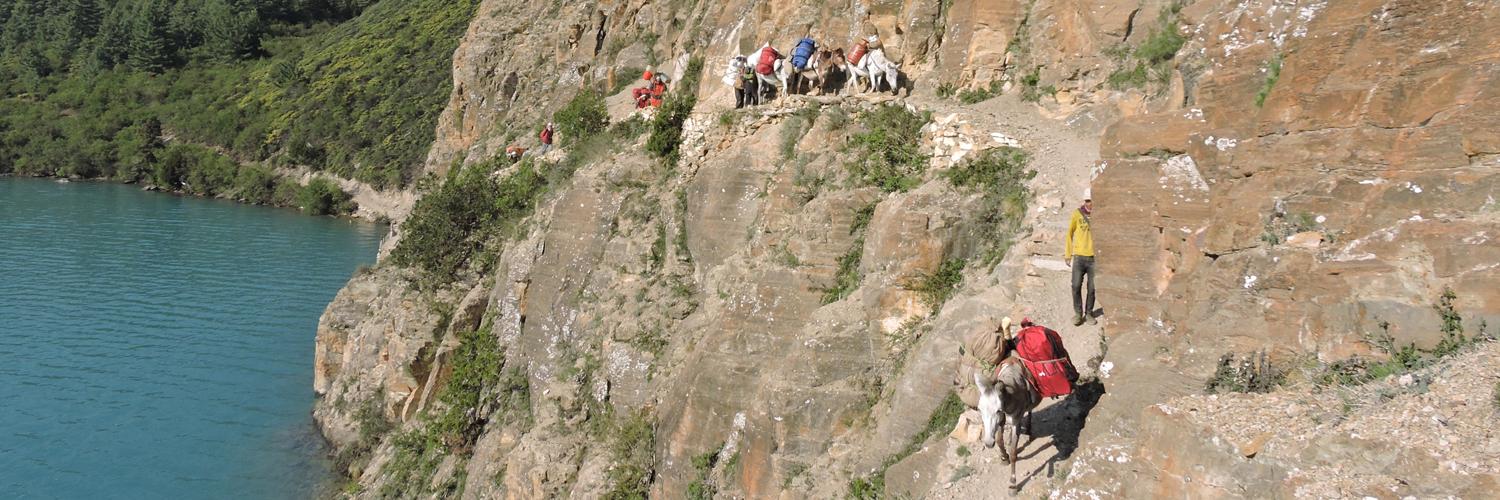Upper Dolpo, a name that portrays images of a remote and untamed land, is appropriately nicknamed the "Wild West" of Nepal. Tucked away in the far northwestern corner, bordering Tibet, this region offers a challenging yet rewarding trek for seasoned adventurers seeking a taste of true Himalayan remoteness. Here's a glimpse into what awaits those who dare to conquer Upper Dolpo.
A Journey through Time
Stepping into Upper Dolpo feels like stepping back in time. Here, traditional ways of life flourish, seemingly untouched by the modern world. Villages hang on to rugged mountainsides, adorned with prayer flags that flutter in the crisp Himalayan air. The people, descendants of ancient Bon and Buddhist traditions, greet you with warm smiles and a genuine curiosity.
Untamed Beauty and Challenging Terrain
The landscape itself is a masterpiece of raw, untamed beauty. Crystal-clear turquoise lake like Phoksumdo Lake at 3,600 meters, go together with snow-capped peaks in the blue sky. Deep canyons carved by the mighty Karnali River crawl through the dramatic terrain. You will be awestruck by the vastness of Shey Phoksundo National Park, a haven for endangered wildlife like snow leopards and blue sheep.
A Test of Physical Strength
Upper Dolpo is not for the faint of heart. The remoteness relates to a challenging trek. High altitudes, with some sections of the trek exceeding 5000 meters (16,400 ft), demand a slow and steady pace for acclimatization. The trails can be rough and rugged, requiring a good level of fitness and strong legs. You need to be prepared for dramatic weather changes, from bone-chilling nights to occasional bursts of rain or snow.
Beyond the Challenge, Unforgettable Rewards
Despite the physical demands, the rewards of an Upper Dolpo trek are immense. You will feel a great sense of accomplishment after conquering this challenging trail. You can witness the sunrise paint the snow-capped peaks with a golden color, which is a moment to last forever in memory. The cultural immersion, from visiting ancient monasteries adorned with prayer wheels to interacting with the hospitable Dolpo people, offers a glimpse into a way of life not witnessed in the modern world.
Planning your journey to Upper Dolpo
Upper Dolpo consists of rugged landscapes with ancient monasteries and influenced by Tibetan culture. It's less frequented by tourists due to its remote location and challenging accessibility. Here’s some key factors to consider while planning your Upper Dolpo Trek.
Best Time to Trek
The best time to visit Upper Dolpo is during the spring (March-May) and autumn (September-November) seasons. These months offer clear skies, pleasant temperatures, and minimal chances of rain or snow.
Obtaining Permits
Upper Dolpo is a restricted trekking area in Nepal where a special permit RAP (Restricted Area Permit) is required priced at US$500 per person. Other involved permits are Shey Phoksundo National Park Permit and Trekking Information Management System (TIMS) Card. Trekkers must go through a registered trekking agency like Marron Treks to obtain permits and can’t trek individually in the Dolpo region.
Getting to Dolpo Region
You need to take two flights from Kathmandu to reach the trek-start point to Dolpo. Initially, there is a flight from Kathmandu to Nepalgunj, a bustling town in southwestern Nepal. The flight takes approximately 50 minutes. It’s a one-night halt at Nepalgunj and the next morning another flight takes you to Juphal Airport, the gateway to Upper Dolpo. Jupal has a small airstrip, and flight times are around 45 minutes. After the trek, the return journey is also the same to Kathmandu.
Accommodation
Unlike treks in more developed areas, Upper Dolpo offers a mix of teahouses and camping during your journey. In the lower regions of the trek, you'll find basic lodges scattered throughout the villages. As you ascend to higher altitudes, teahouses become scarce, so the only option is a fully organized camping trip.
Embrace the Simple: Be prepared for basic amenities in teahouses along the route. Pack essentials like sleeping bags, toiletries, and water purification tablets.
Acclimatization
Upper Dolpo reaches high altitudes, so proper acclimatization is essential to prevent altitude sickness. You need to ascend slowly allowing your body enough time to adjust to the decreasing oxygen levels. Your itinerary should have enough acclimatization days, especially after significant altitude gains. Drink plenty of water throughout the day to stay hydrated and aid your body's acclimatization process. Be careful of your body's signals. If you experience symptoms of altitude sickness then immediately descend to a lower altitude.
Preparation
Upper Dolpo involves long days of trekking at high altitudes, demanding a strong cardiovascular system. You should aim for at least 3-4 running sessions per week, gradually increasing distance and incorporating interval training for a boost. You can find stairs or a sturdy platform and perform step-ups to strengthen your legs for uphill climbs. You need to start your training program well in advance (ideally 3-4 months) and gradually increase the intensity and duration of your workouts. Fuel your body with nutritious foods rich in carbohydrates, protein, and healthy fats to provide sustained energy throughout your training and the trek itself.
Upper Dolpo is an adventure in the Himalayas for those seeking a true wilderness experience. It's a challenging trek, but you will be rewarded immensely. If you're an experienced trekker looking for untouched beauty, a rich cultural heritage, and a test of your physical and mental limits, then Upper Dolpo Trek is the right choice.
Author: Marron Treks
Date: 20th June, 2024


